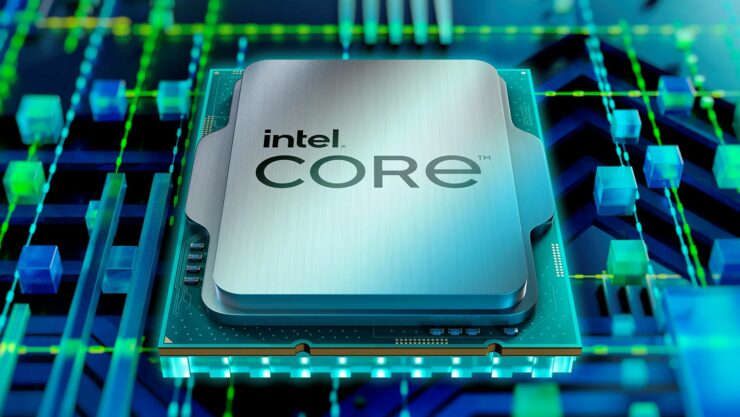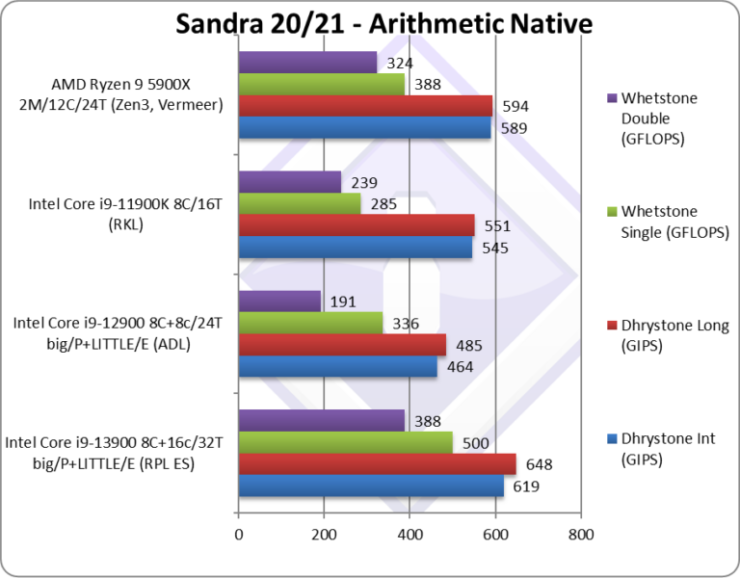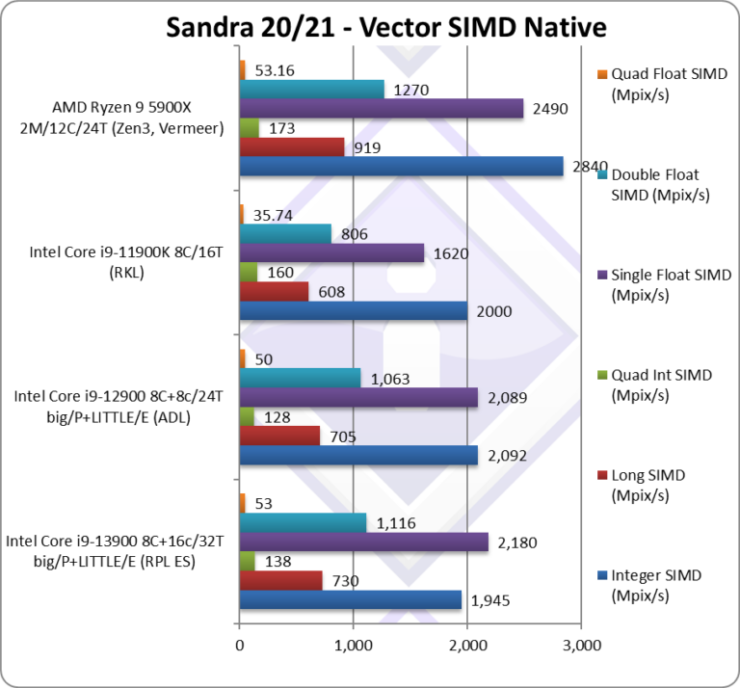
Intel’s Raptor Lake Desktop CPUs launch later this year to tackle AMD’s Zen 4 ‘Raphael’ lineup and it looks like SiSoftware has once again managed to publish a mini-review of a Core i9-13900 CPU with 24 cores and 32 threads in an early engineering state against Intel’s Alder Lake & AMD Zen 3 chips.
Intel Raptor Lake Core i9-13900 ES CPU Up To 50% Faster Than Alder Lake Core i9-12900 At a Low Clock Speed of 3.7 GHz
The 13th Gen Intel Raptor Lake CPUs will be combing the new Raptor Cove P-Cores and Gracemont (E-Cores) in an optimized 10nm (Intel 7+) package. Compared to Intel’s Alder Lake CPUs, the Raptor Lake chips will come with a host of improvements besides just more cores and clock speeds. These include:
- Support for up to DDR5-5600 memory (JEDEC)
- 20% Larger L3 cache (Up To 36 MB Unified)
- 2x Larger L2 cache (Up To 32 MB)
- Support For AVX/AVX2 on E-Cores
- No Support For AVX-512 (Just Like Alder Lake-S)
The Raptor Lake CPU sample tested is an Intel Core i9-13900 which features 8 P-Cores and 16 E-Cores for a total of 24 cores and 32 threads. The chip was running at max clock speeds of 3.7 GHz for the P-Cores and 2.76 GHz for the E-Cores. That’s really low from the retail version which will be offering over 5.5 GHz speeds as mentioned in various leaks. The CPU is equipped with 32 MB of L2 cache (8 x 2 MB for P-Cores / 4 x 4 MB for E-Cores) and 36 MB of L3 cache for a combined total of 68 MB of ‘Gaming’ cache.
Coming to the benchmarks, it is not mentioned what exact test setup was used and if the memory was indeed running at DDR5-5600 speeds. But with that said, the results are very impressive for an ES chip with such low clock speeds. The Intel Core i9-13900 ‘Raptor Lake’ CPU offered up to 50% uplift over the Intel Core i9-12900 in Whetstone FP32 tests and an impressive 2x gain in the FP64 tests. The chip ended up faster than both, the Intel Core i9-12900 and AMD Ryzen 9 5900X which is good for the upcoming lineup.
The results above were with non-SIMD code so entering the SIMD workload segment, the overall performance takes a hit and we see the Intel Raptor Lake Core i9-13900 CPU ending up just 4-6% faster than Alder Lake. The Intel Core i9-11900K does deliver better performance thanks to its AVX-512 capabilities that are missing from Alder Lake & Raptor Lake CPUs. AMD also shows a huge lead here and with AVX-512 coming to Zen 4 CPUs, they can end up having a big lead over Raptor Lake in this particular segment.
Intel Raptor Lake Core i9-13900 Leaked Benchmarks (Credits: SiSoftware)
| Native Benchmarks | Intel Core i9-13900 8C+16c/32T big+LITTLE (RPL) | Intel Core i9-12900 8C+8c/24T big+LITTLE (ADL) | Intel Core i9-11900K 8C/16T (RKL) | AMD Ryzen 9 5900X 12C/24T (Zen3) | AMD Ryzen 9 5900X 12C/24T (Zen3) |
|---|---|---|---|---|---|
| Native Dhrystone Integer (GIPS) | 619 [+33%] | 464 | 545 | 589 | RPL is 33% faster than ADL |
| Native Dhrystone Long (GIPS) | 648 [+34%] | 485 | 551 | 594 | A 64-bit integer workload RPL is 34% faster. |
| Native FP32 (Float) Whetstone (GFLOPS) | 500 [+49%] | 336 | 285 | 388 | With floating-point, RPL is 50% faster |
| Native FP64 (Double) Whetstone (GFLOPS) | 388 [+2x] | 191 | 239 | 324 | With FP64 RPL is 2x faster! |
| Native Integer (Int32) Multi-Media (Mpix/s) | 1,945 [-7%] | 2092 | 2000 | 2840 | RPL is 7% slower than ADL here. |
| Native Long (Int64) Multi-Media (Mpix/s) | 730 [+4%] | 705 | 608 | 919 | With a 64-bit, RPL is 4% faster. |
| Native Quad-Int (Int128) Multi-Media (Mpix/s) | 138 [+8%] | 128 | 160 | 173 | Using 64-bit int to emulate Int128 RPL is 8% faster. |
| Native Float/FP32 Multi-Media (Mpix/s) | 2,180 [+4%] | 2089 | 1620 | 2000 | In this floating-point vectorised test RPL is 4% faster |
| Native Double/FP64 Multi-Media (Mpix/s) | 1,116 [+5%] | 1063 | 806 | 1270 | Switching to FP64 RPL is 5% faster |
| Native Quad-Float/FP128 Multi-Media (Mpix/s) | 53 [+6%] | 50 | 35.74 | 53.16 | Using FP64 to mantissa extend FP128 RPL is 6% faster |
So in conclusion, the Intel Raptor Lake Core i9-13900 CPU, for its ES state, does perform really well but it would be better if we wait for the final performance numbers to show up since clocks do play a big role in the end. SiSoftware has given the following taglines in regards to Raptor Lake for now:
- In legacy ALU/FPU tests, RPL shows a large 33-50% improvement over ADL even at lower clocks which is tremendous.
- In heavy vectorised/SIMD tests, RPL sees only 5-8% improvement over ADL (at lower clocks) which is encouraging but perhaps not a surprise as the extra Atom cores are not going to provide much uplift. We are waiting for additional benchmark results to have a better understanding.
- The huge L2 combined caches (16+16 = 32MB) and the increased L3 (36MB unified) finally overtake/match AMD’s Zen3 – but now with Zen2-3D V-Cache and forthcoming Zen4 (1MB L2 per core vs. 512kB) it may still not be enough.
The Intel 13th Gen Raptor Lake Desktop CPUs are expected to launch later this year and will be supported by the existing LGA 1700/1800 socketed platforms with both DDR5 and DDR4 DRAM support.
Intel Mainstream Desktop CPU Generations Comparison:
| Intel CPU Family | Processor Process | Processors Cores/Threads (Max) | TDPs | Platform Chipset | Platform | Memory Support | PCIe Support | Launch |
|---|---|---|---|---|---|---|---|---|
| Sandy Bridge (2nd Gen) | 32nm | 4/8 | 35-95W | 6-Series | LGA 1155 | DDR3 | PCIe Gen 2.0 | 2011 |
| Ivy Bridge (3rd Gen) | 22nm | 4/8 | 35-77W | 7-Series | LGA 1155 | DDR3 | PCIe Gen 3.0 | 2012 |
| Haswell (4th Gen) | 22nm | 4/8 | 35-84W | 8-Series | LGA 1150 | DDR3 | PCIe Gen 3.0 | 2013-2014 |
| Broadwell (5th Gen) | 14nm | 4/8 | 65-65W | 9-Series | LGA 1150 | DDR3 | PCIe Gen 3.0 | 2015 |
| Skylake (6th Gen) | 14nm | 4/8 | 35-91W | 100-Series | LGA 1151 | DDR4 | PCIe Gen 3.0 | 2015 |
| Kaby Lake (7th Gen) | 14nm | 4/8 | 35-91W | 200-Series | LGA 1151 | DDR4 | PCIe Gen 3.0 | 2017 |
| Coffee Lake (8th Gen) | 14nm | 6/12 | 35-95W | 300-Series | LGA 1151 | DDR4 | PCIe Gen 3.0 | 2017 |
| Coffee Lake (9th Gen) | 14nm | 8/16 | 35-95W | 300-Series | LGA 1151 | DDR4 | PCIe Gen 3.0 | 2018 |
| Comet Lake (10th Gen) | 14nm | 10/20 | 35-125W | 400-Series | LGA 1200 | DDR4 | PCIe Gen 3.0 | 2020 |
| Rocket Lake (11th Gen) | 14nm | 8/16 | 35-125W | 500-Series | LGA 1200 | DDR4 | PCIe Gen 4.0 | 2021 |
| Alder Lake (12th Gen) | Intel 7 | 16/24 | 35-125W | 600 Series | LGA 1700/1800 | DDR5 / DDR4 | PCIe Gen 5.0 | 2021 |
| Raptor Lake (13th Gen) | Intel 7 | 24/32 | 35-125W | 700-Series | LGA 1700/1800 | DDR5 / DDR4 | PCIe Gen 5.0 | 2022 |
| Meteor Lake (14th Gen) | Intel 4 | TBA | 35-125W | 800 Series? | LGA 1851 | DDR5 | PCIe Gen 5.0 | 2023 |
| Arrow Lake (15th Gen) | Intel 20A | 40/48 | TBA | 900-Series? | LGA 1851 | DDR5 | PCIe Gen 5.0 | 2024 |
| Lunar Lake (16th Gen) | Intel 18A | TBA | TBA | 1000-Series? | TBA | DDR5 | PCIe Gen 5.0? | 2025 |
| Nova Lake (17th Gen) | Intel 18A | TBA | TBA | 2000-Series? | TBA | DDR5? | PCIe Gen 6.0? | 2026 |
The post Intel Core i9-13900 ‘Raptor Lake’ Early CPU Sample Tested, Up To 50% Faster Than Core i9-12900 ‘Alder Lake’ at Just 3.7 GHz Clock Speeds by Hassan Mujtaba appeared first on Wccftech.




